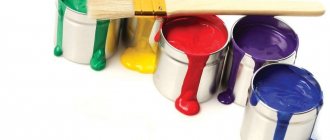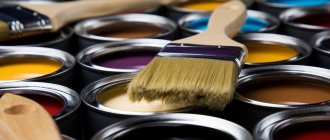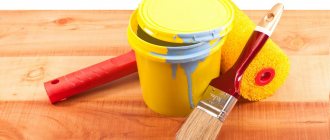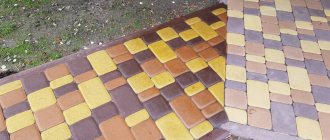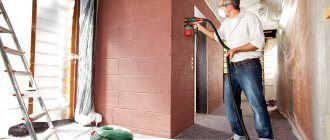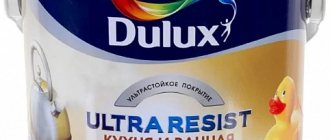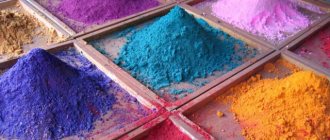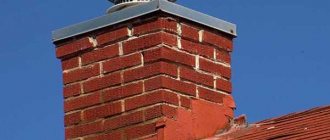It happens that owners of buildings covered with thin-sheet steel with zinc protection have to look for something to paint the galvanized roof of their house in order not to drive corrosion under the paintwork, but to stop the destruction of the roof metal once and for all. There are quite a lot of brands of varnishes and paints on the market, but not all of them are equally suitable for treating galvanized surfaces.
Why do you need to paint a galvanized roof?
Oddly enough, the very question of the need to paint a galvanized roof often confuses future owners. A confusing myth, quite common among car enthusiasts and DIYers, is that galvanized metal, even in extreme conditions of city streets, does not rot or rust. Therefore, no matter how formally, there is no reason to paint the galvanized roof.
In reality, the situation with galvanized roofing is more complicated and confusing:
- Zinc is a relatively soft metal, therefore, during transportation and installation, scratches up to 0.1 mm deep appear on the galvanized surface;
- The galvanized roof surface turns out to be much less resistant to the abrasive effects of wind with raised dust and fine sand.
As a result of sand friction on shiny metal, especially in the area of the ridge, eaves and roof overhangs, bald stripes appear without galvanized protection. If you do not paint the roof in time, a whitish coating will appear quickly enough, and then it will not be easy to stop the corrosion process.
For your information! After the galvanized layer is abraded, rust begins to penetrate under the protection, so the size of the affected surface can be significantly larger than the visible stain.
Initially, the shiny galvanized seam roof gives the entire structure a festive look, although many owners prefer more natural or natural colors instead of galvanized, for example, the paints of fired tiles or the colored colors of a bitumen roof. This is another way to paint a galvanized steel roof; the sooner you start painting, the more durable the decorative layer will be.
Features of painting a galvanized roof
There are several ways to paint a galvanized iron roof; the tools and painting techniques are practically no different from those used to apply paint to a regular metal surface, for example, when painting a metal gate or a black steel fence.
But zinc is an unusual metal; its structure is such that, regardless of the method of application to thin sheet steel, the galvanized surface is formed from a huge number of microcrystals. If you touch the galvanized surface with your fingers, the thin zinc film will seem slightly greasy, as if a small amount of silicone grease had been applied to it.
Sometimes would-be craftsmen, before painting a galvanized roof, treat the metal with a solvent, just as is done when applying paint to ordinary black steel. As a result, the paint lies unevenly on the roof surface, often even rolling off in microdrops.
Therefore, before painting galvanized iron on a roof, you will need, at a minimum, to properly prepare the surface and carry out a treatment that increases the adhesion and stability of the paint base.
How to paint the roof of a country house in Moscow and the Moscow region.
There are several colors of paints that can be used to paint the roof of a summer house. All this requires specialized paint. For example, gray color is suitable for applying to wooden walls and corners, and silver is suitable for painting the inner layers of the roof, as well as for arranging verandas and gazebos. It is almost impossible to replace each of these shades, so it is better to think in advance which color to choose. When painting a wooden house, it is important to remember that such paints protect the wood from fire and insects, and are also flammable and therefore require appropriate skills and knowledge from the artist. Therefore, first of all, when buying paint, pay attention to the fact that it is exactly the same as the one that you will use when painting the roof of your dacha.
How to paint galvanized iron on a roof
The most difficult issue will be the selection of paint and varnish material suitable for painting seam galvanization. Of course, you can simply buy special paint marked “for galvanized surfaces” and completely trust the experience of the manufacturer of paints and varnishes.
Paint for galvanized roofing must satisfy at least three conditions:
- Possess high adhesion to galvanized coating;
- The paint material should not interact with zinc;
- The paint layer must have high elasticity and strength, not crack or peel under conditions of thermal expansion of the galvanized roof metal.
But the specialized protective compounds used for coatings on galvanized roofs in industry are not cheap. Therefore, the dilemma always arises - to use an available specialized zinc mixture or to paint a galvanized roof with a beautiful branded paint.
Paint for metal roofs against rust - features
For the production of roofing, inexpensive carbon steel is used, which is easy to process. In production, the metal is coated:
- A layer of zinc;
- Polymers;
- Paint and varnish materials.
Over time, any coating cracks, fades, wears out from precipitation, exposure to dust under wind load. To restore the protective layer, roofing paints on various bases are used. This treatment improves the aesthetic appearance of the roof.
Experts recommend painting galvanized roofing with special compounds immediately after installation or six months later, weather permitting.
This treatment improves the aesthetic appearance of the roof.
Requirements for roofing paints
Among the wide range of paints and varnishes, it is difficult to immediately choose the right paint for an iron roof; which is better, everyone decides individually, depending on the type of roofing iron.
Any paint and varnish composition must have:
- Moisture resistance to protect the metal from exposure to precipitation;
- Insensitive to ultraviolet radiation, it is better to choose paintwork materials with persistent pigments;
- Elasticity, each alloy exhibits linear expansion when heated, the coating film should not crack when the temperature changes;
- Resistant to mechanical load, abrasion when exposed to branches of nearby trees, birds should not damage the protective layer with their claws;
- Anti-corrosion properties, mixtures must contain inhibitors, rust converters;
- The ability to tint so that you can get the desired shade;
- High adhesion, this quality is especially important for perfectly smooth surfaces.
It is better to choose paintwork materials with persistent pigments.
It is important to take into account the features of the factory coating and follow several recommendations:
- Conventional facade coatings for metal are not suitable for galvanizing impregnated with a special composition. Compositions with thixotropy are required - the ability to quickly liquefy before application and instantly thicken when exposed to air.
- For metals, choose coatings with good hiding power so that a uniform layer is created during application.
- It is undesirable to use ordinary enamels for corrugated sheets; the metal roof “plays”, the hardened layer of the enamel coating bursts and begins to peel off. The profile is painted with paint of increased elasticity, long service life.
For reference: over paint with a glossy effect, it is recommended to use nitrocellulose or another varnish comparable to the coloring composition for iron in order to extend the service life of the decorative protective coating. The polymer or resin film is elastic.
For metals, choose coatings with good hiding power so that a uniform layer is created during application.
How not to paint galvanized steel
Protective coated roofing material should not be painted with paint compounds containing high acid salts or alkaline soaps, commonly used in paints to promote adhesion and convert rust to iron phosphate. Unlike steel, the zinc layer quickly dissolves with the formation of amphoteric compounds, as a result of which the paint peels off and comes off the roof surface along with the galvanized coating.
The second limitation is the presence in the paint of special toners or pigments based on powdered copper, tin or antimony. If you paint galvanized paint with copper pimento paint, even in oxidized form, the process of degradation of the roofing coating still occurs, although at a noticeably lower rate than with direct contact with copper.
Preparatory stage for painting the roof
When preparing to paint the roofing, if there is old paint, it is worth getting rid of it. Then you need to sweep away all the dirt that appeared there. The next step will be washing the roof. Next, it is degreased and given time to dry. If cracks or holes are noticed in the roof, they must be repaired. To complete this work you will need:
- soldering iron;
- special sealant;
- adhesive composition.
Sealing of various cracks is done using patches made of metal or plastic. The work is carried out like this:
- Using sandpaper, remove old paint and rust from the areas where the sheets meet.
- The metal sheets are tightly fitted to each other.
- After moistening the brushes with zinc chloride, treat the joints.
- The hot soldering iron is wiped with an alcohol solution.
- All defects are soldered.
- Cool sealed cracks.
- Remove excess solder.
Also, the process of sealing defects in the roofing is possible without the use of a soldering iron. To do this, you only need a special adhesive composition and sealant. This method of eliminating roof defects is the most convenient and fastest. Before you begin painting the roof, all cracks must be sealed with epoxy putty.
Acrylic paints
The most popular materials for galvanized roofs are acrylic and water-based. Acrylates and polymers based on them have the least corrosive activity towards zinc, so paints of this class can be used to paint standing seam roofs in bright colors.
But the adhesion strength of acrylic coatings to galvanized metal is low, so they can be used for small parts, for example, additional elements. For example, paint under the brand name “Tsikrol” and its analogues can be applied with a spray gun, a brush or a regular paint roller.
For full-size roof slopes covered with iron, it is best to use composite mixtures of acrylic resins and cyclohesanone formaldehyde dissolved in a polar solvent, usually based on ethyl and butyl alcohol.
Aluminum and zinc powder are used as coloring pigments.
For your information! If the metal from which the filler toner is made is located to the left of zinc in the series of electrical voltages or potentials of the metal, then a galvanic couple is not formed.
In this sense, aluminum is the best material, since due to the oxide film it does not show activity when in contact with solvents.
An example of a good choice of paint for new galvanized roofs is the “Serebrol” composition, which has a semi-matte sheen. To achieve high quality coating, it is enough to paint a galvanized roof with two layers of enamel. The Belarusian MAV BASTION KR-12 enjoys a good reputation.
Top most popular roofing paints
Below we will reveal in detail all the pros and cons of the most popular manufacturers of paint and varnish products among consumers.
Characteristics of HAMMERIGHT paint
The advantages of the composition are:
- can be applied to the area “affected” by rust;
- high wear resistance and long service life;
- high adhesion;
- resistance to corrosion processes;
- providing a beautiful “appearance” and a wide choice of colors;
- no need to wait long for drying;
- resistance to UV rays.
Now about the cons:
- the possibility of salt deposits appearing;
- short-term protection against rust (corrosion can “make itself felt” after three to four years);
- If degreasing is done poorly, the coating may crack;
- There may be bubbles when using a paint roller.
Description of "TIKURILLA"
The advantages of this Finnish paint product are almost the same as the previous one, although there are also unique positive qualities:
- higher resistance to the effects of the atmospheric environment, chemicals and moisture;
- better heat resistance (can “withstand” up to eighty degrees and not crack in the heat) and adhesion to metal structures;
- the paint is not afraid of severe frosts.
Let's talk about "CYCROLE"
After applying this composition you will get a matte surface. The positive properties are:
- it consists of special anti-rust components;
- moisture resistance;
- high adhesion with galvanized sheet;
- uniformity of distribution;
- there is no need to apply a primer layer;
- low material consumption (one paint layer is enough);
- high color fastness;
- quick drying;
- she is not afraid of extreme cold.
What are the properties of other paints?
Let's give a couple of examples and characteristics of domestic paint and varnish products for painting roofs.
UNICOM. This composition of Russian origin has high fire safety and is used for products that “suffer” from exposure to high temperatures.
"SILVER". This one-component enamel product has anti-corrosion properties.
The material is used for galvanizing and for steel.
The paint is made on the basis of aluminum powder, which only increases the protection of the roof. In addition, it contains resins from perchlorovinyl, epoxy, special impurities and organic solvents.
In addition to resistance to corrosive processes, it is not afraid of moisture, mechanical deformation and household chemicals (for example, oil or gasoline).
"ROSTEX SUPER". This is a special primer for galvanizing.
The soil is also used for pipelines for various purposes.
Polyurethane paints for galvanized roofs
Coatings based on polymer urethane resins are considered more resistant to external loads. Experts recommend using polyurethane paint and varnish compositions in cases where there is a huge amount of sand, ice and other materials on the roof that have an abrasive effect on the galvanized coating.
Polyurethane and alkyl-urethane paints perfectly preserve the color scheme; it is believed that it is best to paint old and fairly worn roofs with such materials. For example, inexpensive “Unikom” adheres perfectly and is held on to a metal roof that has been worn to holes, even if areas and traces of galvanized coating remain on the surface. Whereas, before using the most popular acrylic composition “Tsikrol”, it is best to first paint the roof with a primer that improves adhesion to zinc.
Applying paint
It is advisable to first prime the prepared surface of a galvanized roof. Priming is carried out using a special solution for galvanized coatings, applied to the surface with a fleecy roller with a long handle. In hard-to-reach places it is better to use a brush.
After the first coat of primer has dried (8 hours), the process is repeated using a primer solution with anti-corrosion properties. This solution also needs to be dried thoroughly for the time specified in the attached instructions. Paint is applied to the roof over the dried primer in 2-3 layers. This will give the coating additional strength.
Currently, there are paints that can be applied without first priming the surface. This point should be specified in the instructions on the paint can. Apply paint starting from slopes. When painting, the paint is shaded along the slope. After this, the roof ridge is painted in the direction of the slopes. Particular care must be taken to paint inter-sheet seams and fastening areas to ensure their complete tightness.
Composite and alkyd paints and varnishes
If the galvanized roof of a house is exposed to powerful gusts of wind, or there are other unfavorable conditions that negatively affect the condition of the roof, then it is best to use more modern versions of paint coatings based on epoxy and urethane resins to protect galvanized metal.
For example, you can use the same “Serebrol” based on perchlorovinyl and epoxy resins. This composition is perfect not only for a seam roof; the material is ideal for painting galvanized gutters and downpipes. This way you can reduce the wear of the drainage part by almost three times.
Alkyd enamels are used for painting roofs in limited quantities. And although a roof painted with an alkyd-urethane composition looks very beautiful, the paint coating does not adhere very firmly to a galvanized surface. Therefore, in order to paint zinc, you have to buy additional primer or use more expensive “three-in-one” compositions with an adhesive primer, a shiner and a corrosion inhibitor.
Advice! If you have a choice, it is best to paint galvanized paint with light-colored paint, without pigments based on copper and iron oxide.
This will not only improve the protection of the coating, but will also hide light spots of oxidized zinc.
How to paint a galvanized roof of a house
The method of applying a protective layer to galvanizing depends on the size of the roof and the characteristics of the material. First of all, it is necessary to prepare the surface of the galvanized roof.
The stripping scheme looks like this:
- The old layer of paint is removed. If the new and old coatings are of the same type, made on the same polymer base, then you only need to remove the outer oxidized layer of paint;
- Apply primer, it is best to use Rostex Super or its analogues; the primer base was specially developed as an adhesive for acrylic and composite coatings;
- Dry the primer layer thoroughly and paint.
For your information! Many paints and varnishes can be applied to primer or directly galvanized, even at subzero temperatures. If it is not possible to paint during the warm part of the day, then it is better to postpone the work until there is a steady frost.
It is best not to paint in the range from 0°C to +8°C due to the formation of a layer of condensation on the roof.
Why do you need to paint?
Even at the production stage, an oily ball is applied to galvanized iron sheets to counteract negative environmental factors. True, this protection lasts for a year and a half, and then this layer loses its “magic power” due to exposure to precipitation.
For this reason, such material should be painted with a special coating. In this way you can ensure:
- protection against corrosion processes;
- attractiveness of the roof (moreover, you can choose the color that “your soul desires”);
- Despite all the high cost of painting, you will still save your budget from even greater costs for a complete replacement of the roof.
Preparing a new galvanized roof
Experts recommend painting a new galvanized roof after a year of operation; during this time, a thin layer of oxidized zinc forms on the metal surface. As a result, paint adhesion increases by an order of magnitude.
The hardest part to paint is a newly installed galvanized roof. Initially, the roof metal is washed with a brush with sand and caustic soda, thereby removing the layer of technological lubricant remaining on the galvanized surface from the factory. The next step is simply rinsing the surface with clean water.
Metal painting
Immediately before applying paint, rub the metal roof with a clean, dry rag soaked in solvent 647 or white spirit. It is necessary to paint the metal within half an hour from the end of treatment.
A ladder made of boards is laid on the roof, along which they move during work. The most convenient way to paint a seam roof is with a spray gun mounted on an extension rod. In this case, you will only need one ladder to paint the stingray.
Painting the roof of a house with rubber paint in Moscow and the Moscow region.
Painting the roof of a slate house | from 350.r/m2 |
Painting metal tiles on the roof of a house price | from 370.r/m2 |
House roof painting cost | from 360.r/m2 |
Painting the metal roof of a house | from 390.r/m2 |
Painting a galvanized house roof | from 450.r/m2 |
House roof painting price per square meter | from 390.r/m2 |
Painting the iron roof of a house | from 250.r/m2 |
Painting the roof of a house with silver | from 450.r/m2 |
Painting the roof of a private house | from 240.r/m2 |
Painting the roof of a house with your own hands | from 460.r/m2 |
Options for painting the roof of a house | from 320.r/m2 |
Painting a rusty house roof | from 310.r/m2 |
Cost of painting a metal roof on a house | from 550.r/m2 |
Painting the roof of a country house | from 440.r/m2 |
Price list for painting the roof of a house | from 340.r/m2 |
House roof painting services | from 470.r/m2 |
Painting the roof of a house with rubber paint | from 510.r/m2 |
Painting the roof of a house with red lead | from 520.r/m2 |
Painting the roof of a house with a roller | from 540.r/m2 |
Cost of painting the roof of an iron house | from 530.r/m2 |
Tips and tricks
Maximum surface quality can only be achieved in calm weather, so the best time to paint the roof is a quiet autumn morning. Cleaning and preparing the roof surface can be done the evening before the work.
The second layer is applied to the metal in the evening, after thoroughly drying the surface. During this time, it is important to inspect the applied first layer and identify flaws and places that require touch-up.
The last pass is to tint the details of the drainage system and the ridge.

